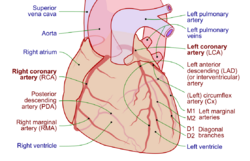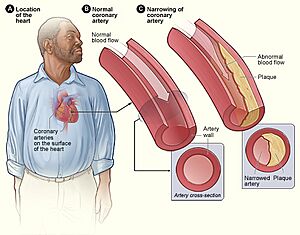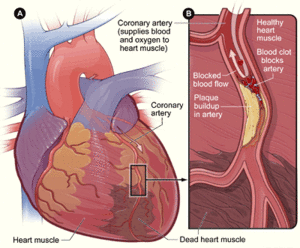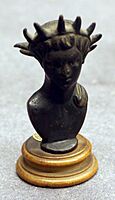Coronary arteries facts for kids
Quick facts for kids Coronary arteries |
|
|---|---|
 |
|
| Coronary arteries (labeled in red text) and other major landmarks (in blue text) |
The coronary arteries are special blood vessels. They are like tiny roads that carry fresh, oxygen-rich blood to your heart muscle. Just like any other part of your body, your heart needs a constant supply of oxygen to work properly and stay healthy.
These important arteries wrap all around your heart. The two main ones are the left coronary artery and the right coronary artery. Doctors also group these arteries by where they are located on the heart. Some are epicardial, meaning they are on the outside surface of the heart. Others are microvascular, which means they are tiny and closer to the inside of the heart.
If these arteries don't work well, your heart might not get enough oxygen and nutrients. This can make it hard for your heart to pump blood to the rest of your body. Problems with your coronary arteries can be serious. They might lead to chest pain called angina, a heart attack, or even worse.
Contents
How Your Coronary Arteries Are Built
Your coronary arteries are mainly made up of the left and right coronary arteries. Each of these main arteries has several smaller branches. You can see how they branch out in the picture below.
- The Aorta is the body's main artery.
- The Left coronary artery branches off the aorta.
- It splits into the Left anterior descending artery.
- It also splits into the Left circumflex artery.
- Sometimes, it gives off the Posterior descending artery.
- A third branch, called a ramus or intermediate artery, can also form.
- The Right coronary artery also branches off the aorta.
- It gives off the Right marginal artery.
- It often gives off the Posterior descending artery.
- The Left coronary artery branches off the aorta.
The left coronary artery starts near your aortic valve. It sends blood to the left side of your heart. This artery then divides into two main parts. One is the left anterior descending artery. It supplies blood to the front wall of your left ventricle and the wall between the two lower heart chambers. The other part is the left circumflex artery. This one supplies blood to the outer wall of your left ventricle. For about one-third of people, the left coronary artery also supplies the posterior descending artery. This artery sends blood to the back and bottom walls of the left ventricle.
The right coronary artery (RCA) starts near the right side of your aortic valve. It travels along the right side of your heart. The RCA mainly branches into the right marginal arteries. These supply blood to your right ventricle. For about two-thirds of people, the RCA also gives off the posterior descending artery. This artery supplies blood to the back and bottom walls of the left ventricle.
There's also a special artery called the conus artery. Only about 45 out of 100 people have it. This artery can help provide blood to the heart if the left anterior descending artery gets blocked.
What Happens When Coronary Arteries Have Problems
Sometimes, the arteries can become narrow. This often happens because of a process called atherosclerosis. This is when sticky stuff called plaque builds up inside the artery walls. This plaque is made of cholesterol and other substances. When this happens in the coronary arteries, it's called Coronary artery disease (CAD).
As more plaque builds up, it can partly block blood flow to your heart muscle. If your heart doesn't get enough blood, it can't work well. This is especially true when you are active.
- Stable angina is chest pain that happens when you exercise or are stressed. It usually gets better when you rest.
- Unstable angina is more serious. It's chest pain that can happen even when you are resting. It feels worse and lasts longer than stable angina. This means the arteries are much more narrowed.
A heart attack happens if a piece of plaque suddenly breaks off. This can cause a blood clot (called a thrombus) to form. This clot can completely block blood flow to a part of the heart. When this happens, that part of the heart muscle can die.
Coronary artery disease can also lead to heart failure. This means the heart becomes too weak to pump blood effectively. It can also cause arrhythmias, which are problems with the heart's electrical signals.
Sometimes, coronary arteries can tighten up in response to certain signals. This is called a coronary reflex.
There's also a rare condition called spontaneous coronary artery dissection. This is when the wall of a coronary artery tears. It causes severe pain. Unlike CAD, it's not caused by plaque buildup. It often affects younger people, including women who have recently given birth or men who do very intense exercise.
Doctors also talk about "coronary artery dominance." This describes which artery supplies blood to the back and bottom of the heart. For most people (about 80-85%), the right coronary artery does this. This is called "right heart dominant." For a smaller group (7-13%), the left coronary artery does it, making them "left heart dominant." In a few people (7-8%), both arteries supply this area, which is "co-dominant." Interestingly, people who are left heart dominant tend to have more narrowing in their coronary arteries.
Where the Names Come From
The word corona comes from Latin. It means "crown" or "wreath." The coronary arteries were given this name because they wrap around the heart like a crown.
The word artery comes from an old French word, which came from Latin. It used to mean "windpipe" or "artery." It was used for arteries because people once thought arteries were empty after death.
See also
- Coronary circulation
- Left coronary artery
- Right coronary artery
- Heart
- Cardiology
- Coronary artery disease
- Angina
- Unstable angina
- Heart attack
- Cardiac skeleton
- Coronary sinus
- Foramen ovale (heart)
- Patent foramen ovale






